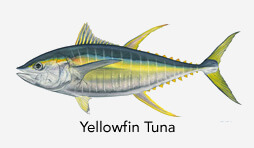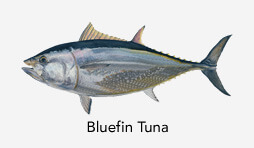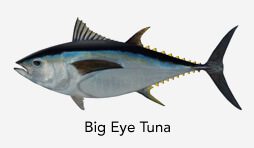Eligible Fish
Atlantic tunas belong to the family Scombridae. Recognized as some of the largest and fastest predators in the oceans, these fishes are designed for speed. Atlantic tunas are well equipped for sustained, rapid locomotion. Their fusiform bodies and lunate tails minimize drag as they move through the water. Small dorsal and ventral finlets minimize turbulence, allowing the tail to propel the fish forward efficiently. Dorsal and pectoral fins also retract into depressions in the body, forming a clean silhouette to cut through the water.
Enhancing the visible characteristics that facilitate locomotion are internal adaptations that stoke the metabolic engine. To satisfy the high oxygen demands of their swimming pace, tunas employ a respiration mode known as ram gill ventilation. This system requires that the fish swim continuously, mouth open to pass sufficient water over its gill surfaces. Ram gill ventilation may be less energy-consuming than the more common respiratory mechanism requiring active pumping of water over the gills.
Another distinction of tunas is their capacity to maintain a body temperature higher than the surrounding water. An elevated internal temperature results from the conservation heat generated by active swimming muscles. This adaptation allows these endothermic animals to expand their geographic range and to dive into deeper, colder waters in pursuit of prey, a decided advantage in the hunt for food.
Opportunistic feeders, tunas consume fishes, cephalopods, and crustaceans that are seasonally available. As apex predators, tunas have few predators’ themselves-humans, primarily, along with billfishes, some sharks, and toothed whales.
Tunas are fairly fecund and relatively long-lived. A spawning bluefin tuna, for example, produces about 30 million eggs, and even though there is high natural mortality among juveniles, adults can live 20 years or more


























.jpg)

.png)





























